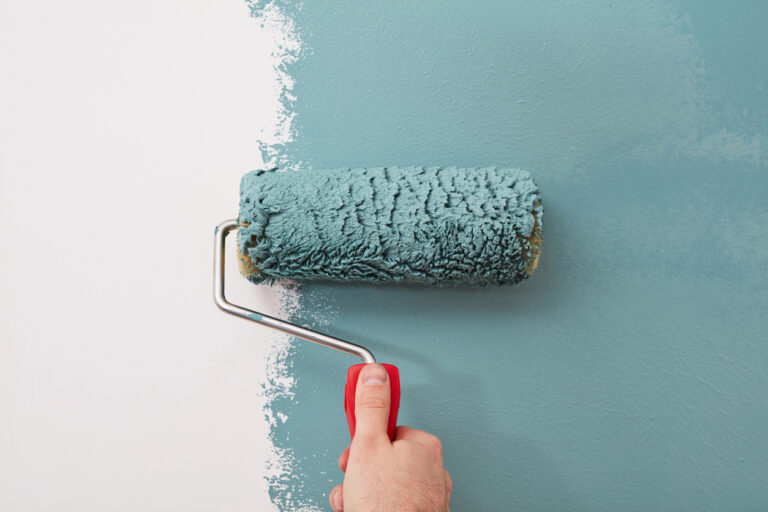On this page
What's next
Earn a high-yield savings rate with JG Wentworth Debt Relief
Interior Painting Mistakes and How to Avoid Them
by
JG Wentworth
•
April 2, 2025
•
7 min

Interior painting seems straightforward enough—buy some paint, grab a roller, and go to town. Yet anyone who has tackled this seemingly simple project knows that achieving professional results requires more than just enthusiasm. From streaky walls to peeling ceilings, painting mistakes can turn your home refresh into a frustrating ordeal.
This guide covers the most common interior painting mistakes and practical solutions to help your next painting project go smoothly.
Skipping Preparation
Perhaps the biggest mistake DIYers make is rushing through or completely skipping proper preparation. It’s tempting to dive straight into the colorful part, but inadequate prep work is responsible for most disappointing paint jobs.
The Problem: Painting over dirty, damaged, or unprepared surfaces leads to poor paint adhesion, resulting in peeling, bubbling, and premature wear.
The Solution: Always clean walls thoroughly before painting. Remove dust, grease, and cobwebs with a damp cloth and mild detergent solution. Fill holes with spackling compound, sand rough areas, and caulk gaps. Remove outlet covers and switch plates. Tape off trim, windows, and doorframes. This prep work typically takes longer than the actual painting, but it’s what separates amateur work from professional results.
Using Low-Quality Paint
The allure of saving money with budget paint is hard to resist, but this economy often backfires.
The Problem: Cheaper paints generally contain less pigment and binders, resulting in poor coverage, uneven finish, and shorter lifespan. You’ll likely need more coats, negating any initial savings.
The Solution: Invest in high-quality paint from reputable manufacturers. Premium paints cover better, apply more smoothly, resist stains, and hold up to cleaning. Focus on paints labeled as “one-coat coverage” or “paint and primer in one” for best results. The extra upfront cost pays dividends in time saved and lasting quality.
Neglecting Paint Finish Considerations
Many DIYers select paint based solely on color, not considering how the finish affects both appearance and functionality.
See: Interior Painting: Types of Paints and Finishes
The Problem: Using the wrong finish can emphasize wall imperfections, create unwanted sheen, or fail to stand up to daily use.
The Solution: Choose finishes strategically for different spaces:
- Flat/Matte: Best for ceilings and low-traffic areas; hides imperfections but less cleanable
- Eggshell/Satin: Ideal for living rooms, bedrooms, and hallways; offers a subtle sheen with decent washability
- Semi-gloss: Perfect for kitchens, bathrooms, and trim; more moisture-resistant and easier to clean
- High-gloss: Reserved for trim, doors, and specialty applications; highly durable but shows every imperfection
Poor Technique with Rollers and Brushes
Improper application techniques lead to visible roller marks, brush strokes, and uneven coverage.
The Problem: Pressing too hard with rollers, using the wrong nap length, or applying paint with inconsistent pressure creates textural issues that are difficult to fix.
The Solution: Use the right tools for your surface—shorter nap rollers (3/8″) for smooth walls, longer naps (1/2″ or 3/4″) for textured surfaces. Load your roller evenly and apply with gentle, consistent pressure in a “W” or “M” pattern, then fill in with vertical strokes. For brushwork, hold the brush at a 45-degree angle and use long, smooth strokes. Keep a “wet edge” by overlapping each stroke with the previous one before the paint begins to dry.
Ignoring Proper Color Testing
The color chip at the store rarely tells the whole story about how a paint will look in your space.
The Problem: Paint colors look dramatically different depending on lighting, surrounding colors, and time of day. What looked perfect in the store might appear too dark, too bright, or have undertones you didn’t anticipate once applied.
The Solution: Never skip testing colors in your actual space. Purchase sample pots and paint large swatches (at least 2 feet square) on different walls. Observe them over several days, noting how they look in morning, afternoon, and evening light. Consider how the color interacts with your flooring, furniture, and adjacent rooms. This small investment prevents costly mistakes and disappointment.
Inconsistent Paint Coverage
Patchy or inconsistent coverage makes even the best color choices look amateurish.
The Problem: Not using enough paint, improper roller loading, or rushing through the job leads to thin spots and uneven color.
The Solution: Follow the manufacturer’s coverage guidelines and err on the side of using more paint rather than less. Properly load your roller (it should be wet but not dripping) and apply with consistent pressure. Don’t stretch paint too far. For dramatic color changes or when covering dark colors, a tinted primer followed by two topcoats is often necessary. Wait for each coat to fully dry before applying the next.
Painting in Poor Lighting
Inadequate lighting during painting is a recipe for missed spots and uneven application.
The Problem: Natural light changes throughout the day, and standard overhead lighting creates shadows that hide imperfections and missed areas.
The Solution: Use portable work lights positioned to illuminate walls from different angles, eliminating shadows. After applying paint, inspect the surface by looking at it from various angles and with different lighting positions. Keep a small brush handy for touch-ups when you spot missed areas. Final inspection in daylight helps catch any remaining issues.
Find Local Interior Painting Professionals
Find Local Interior Painting Professionals
Rushing Between Coats
Impatience with drying times leads to numerous problems with the final finish.
The Problem: Applying a second coat before the first is completely dry can cause pulling, peeling, and an uneven finish. Different paints have different drying requirements.
The Solution: Follow the manufacturer’s recommendations for drying times, which typically range from 2-24 hours depending on the product. Increase drying time in humid or cool conditions. If you’re uncertain, the touch test works well—if the paint feels tacky at all, it needs more time. Remember that “dry to the touch” is not the same as “fully cured,” which can take up to 30 days.
Inadequate Ventilation
Proper ventilation is crucial for both health and paint performance.
The Problem: Poor air circulation extends drying times, potentially traps odors in the paint, and, most importantly, creates health hazards from paint fumes.
The Solution: Open windows and doors when possible. Use fans to create cross-ventilation—position one fan facing inward and another facing outward in different windows. For spaces without windows, use box fans in doorways. Consider using low-VOC or zero-VOC paints to reduce harmful emissions, especially in bedrooms or children’s rooms.
Improper Ceiling Technique
Ceilings present unique challenges that require specific approaches.
The Problem: Painting overhead causes drips, neck strain, and often results in missed spots or uneven coverage.
The Solution: Use an extension pole to reduce strain and provide better leverage and control. Paint ceilings before walls, working in 4×4 foot sections to maintain a wet edge. Always work from the unlit side of the room toward the windows to better see missed spots and inconsistencies. Consider ceiling-specific paints formulated to minimize spattering and provide better coverage.
Overlooking Weather Conditions
Weather affects paint performance more than most people realize, even for interior work.
The Problem: Extreme temperatures or high humidity can prevent proper drying, cause poor adhesion, and affect the paint’s ability to level out smoothly.
The Solution: Aim for painting when temperatures are between 60-85°F with moderate humidity. If possible, avoid painting during extremely rainy periods when indoor humidity spikes. In winter, allow extra drying time between coats. If you must paint in less-than-ideal conditions, consider paints specifically formulated for application in wider temperature ranges.
Final Thoughts
Interior painting is as much about patience and process as it is about color selection. By avoiding these common mistakes, your next painting project will deliver professional-looking results that transform your space and last for years to come.
Remember that proper preparation, quality materials, and thoughtful technique are investments in both the appearance and longevity of your paint job. Taking your time at each stage—from surface preparation to the final coat—will reward you with walls you’ll be proud to show off.
About the author
Recommended reading for you
*Any information provided on this site is for educational purposes only. JGW Connects, LLC is not an agent of you or any third party advertiser on this website. You should rely on your own judgement in deciding which available product, terms and provider that best suits your personal financial requirements. We do not offer financial advice, advisory or brokerage services. We recommend that you consult with our own independent advisors regarding these products and services
JGW Connects, LLC is an independent, advertising-supported comparison site and marketing lead generator and does not play a role in decisioning for any of the third party products advertised on this webpage. JGW Connects, LLC and the JG Wentworth Company family of companies are not affiliated with the companies advertising on this webpage. You are not charged for our services. JGW Connects, LLC may receive a referral fee or other affiliate fee for connecting you with these third-party companies or upon you contracting with a third-party company. We do not make any guarantees that these are the only providers in the marketplace, or that their products or services will meet your needs. The products and services presented to you may or may not be the best, or only options, available.
JGW Connects does not provide any of the products or services advertised and does not make any decisions regarding your eligibility for those products or services. All decisions regarding approval or denial of a particular product or service are the responsibility of the participating company and will vary based upon your particular financial situation, and criteria determined by the company to whom you are matched. Not all consumers will qualify for the advertised rates and terms.






